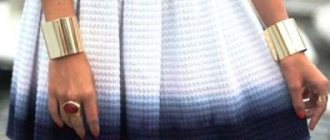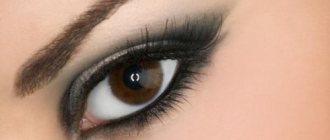Food culture
The nose can be called the architectural center of the face, since it occupies a central position. Finding a woman who considers her nose to be ideally shaped is very difficult; most often, many of them are dissatisfied with this part of the face and often have complexes about it. In total, there are approximately 15 groups into which this part of the face is classified. Each group is based on five basic parameters - base direction, root, length, back shape and tip. All these basic features influence the shape of such an important organ.
A little history
In Ancient Greece and Rome, not only a beautiful body was valued, but also a nose of the correct shape, obviously, this is where the concept of a Roman or Greek nose came from. This shape can be seen on ancient sculptures
, which reflected the standard of female beauty. In Ancient Greece, correct, clear lines were highly valued, so the face had to have large expressive eyes, a thin straight nose and a low forehead with curls of blond hair.
At that time, strict and noble beauty was in fashion. Women practically did not cut their hair; they styled it in a knot and tied it with a ribbon. The hairstyle is called the “Antique Knot” and it is still popular with some girls. In Ancient Egypt, a slender, but not thin body and long legs were highly valued. The Egyptians also constantly used cosmetics, painting themselves bright eyebrows and expressive eyes.
Times are changing, modern girls now pay more attention to the covers of glossy magazines and TV screens. There they find standards of beauty for themselves with ideal body shapes and facial features, the shape of the nose. Much of what they see makes them decide to undergo rhinoplasty.
.
Among Hollywood stars it is difficult to find at least one actor who has not adjusted the shape of his nose. Their profession often pushes them to such measures. This can be clearly seen if you look at the photos of many stars at the beginning of their careers and at the peak of popularity, the difference is obvious.
The Greek nose is considered classic
, it has a straight shape, this part of the face does not need correction. Ancient Greek sculptures are beautiful and perfect, they have ideal body shapes and facial features, and you can notice a characteristic Greek profile. The Olympian gods and children of the gods were endowed with this appearance, which was the standard of beauty.
The Greek nose has its own characteristics, one of which is the continuation of the line of the forehead, but there may also be a slight depression in the area of the bridge of the nose. The recess does not disrupt the shape and single line; ideally, it should start at the roots of the hair and end at the tip of the nose. Appearance of modern Greeks
rarely coincides with the standard, and the classic nose shape is rare. This fact suggests that the Greek nose was a symbol of divine beauty, judging by the photos of statues where they are depicted in profile.
The female Greek nose is always closely associated with a characteristic hairstyle, which emphasizes a beautiful, not very high forehead and a beautiful graceful nose. It differs from men's only in size, so it is thinner and more beautiful.
By its shape you can determine the character of a person
, find out his mental abilities and emotional characteristics, these include:
- pride and independence;
- integrity and leadership;
- affection for friends and aversion to liars;
- generosity and love of money;
- sarcasticness and desire to control the family budget.
Those with a naturally Greek nose are always very restrained, they do not panic, they think logically and cope well with their emotions. Admiral Nelson had a Greek nose
, and among modern celebrities with the classic part of the face from nature or after rhinoplasty are Angelina Jolie, Natalie Portman, Monica Bellucci, Demi Moore.
This shape of the nose also has its own characteristics; it is somewhat elongated with a slightly curved tip, if you look at it in profile. Owners of this form are considered courageous people
, they know how to attack and repel an enemy or rival. Men are distinguished by clear thinking and cold restraint; they are very brave and can protect themselves and their loved ones. Such character traits evoke universal respect, which is why men with a Roman nose often become leaders and enjoy authority in society.
Owners of the Roman profile are distinguished by the following character traits:
- unpredictability and imbalance;
- energetic, they are easy-going;
- kindness and increased sexuality;
- love for beautiful things and decorations, comfort;
- gambling and flammability in relationships with people.
If the Roman nose resembles a beak
, then this indicates a certain aggressiveness, and very often the owners of such a part of the face became adventurers and adventurers. Such people are often considered cold and unreliable. Small nostrils indicate a love of risk, very often taking risks, such people achieve success.
The Roman nose may have a humpback; the descendants of the ancient Romans have always been distinguished by this shape. If it had a raised back it was called eagle, but this does not prevent it from having a beautiful structure. Many famous personalities had a Roman profile - Julius Caesar, Henry IV, Charles V
. In profile, it is clearly visible that the head and face of such people have a courageous and impressive appearance.
No one can say for sure that the shape of the nose really influences a person’s character and his actions, as well as fate or fateful moments in life. However, there is an opinion that by changing the natural shape of this part of the face, the character of a person and his destiny can also change. All that remains is to find out in which direction to change, for the better or for the worse, but no one can answer such a question.
Greek and Roman nose
A distinctive feature of the Greek nose is that it is a continuation of the line of the forehead, sometimes having a small depression in the area of the bridge of the nose. Observing ancient sculptures, you can notice that the Greek nose in women has the same shape as in men, but is smaller in size, therefore it is elegant and beautiful.
During the times of ancient Rome, the Greek nose in women was considered the canon of beauty; a profile photo of such a beauty will show that this part of the face has a straight line starting from the forehead. This feature could not help but leave an imprint on the lady’s character, giving him decisiveness and categorical judgments. A striking example of such a character is, undoubtedly, Cleopatra, who led her subjects with a firm hand. If we turn to modern times, it should be noted that a woman with a Greek nose has every chance of becoming a good leader, showing determination and integrity.
Already in her school years, a girl with such an adornment on her face will become the head of the class and will restore order with a firm hand, showing intolerance to lies. It is quite difficult to become a friend of such a girl because of her demanding attitude towards everyone around her. To be fair, it should be noted that a woman, while demanding quite a lot from a potential friend, is also severe about her shortcomings, trying to get rid of them.
Friendship, born during school and student years, remains a priority throughout life; a woman is so devoted to her friends that at any moment she is able to rush to their aid. The lady with the Greek nose is easy-going; she prefers to engage in extreme sports, and actively involves her friends in them. It won’t be a problem for her to pack up one day and go traveling to the mountains or kayaking down a mountain river.
To understand what a Greek nose looks like in women, it is recommended to pay attention to ancient Greek sculptures, in which this detail has practically no depression on the bridge of the nose or it is very small. This feature indicates the ability to maintain strict control over the family budget, but such a woman cannot be called tight-fisted either. Thanks to this character trait, a lady is able to accumulate a large amount of money sufficient to buy a house and maintain it.
Women with a Greek nose shape are highly sexy, but once they find their soul mate, they will not even think about cheating. Subconsciously, they are looking for a partner with the same activity, and if this is successful, then a strong and harmonious family arises. Thanks to her temperament, the lady creates an atmosphere around herself that can hardly be called calm, but her husband and children like it.
Such women quite often find themselves in creative professions, and before writing a book, they try to experience everything in reality. The result is wonderful novels that sell like hot cakes. Those with a Greek nose can become wonderful pianists, talented artists and bright singers who attract huge crowds of people at their concerts.
Men should take into account the characteristics of such women and not try to make their beloved a housewife, this can lead to a huge scandal and divorce. The lady will not submit to her husband’s wishes; she has many of her own ideas and far-reaching plans. A sufficiently strong union can be created if a man is equal to the potential wife in strength and temperament, or is ready to play second fiddle in the family and business.
Many people, especially artists, turn to plastic surgeons to reshape their nose, this can be seen in the example of some celebrities, comparing their photographs at the beginning of their careers and later. It should be understood that such changes in appearance quite often entail a change in character, so you need to carefully consider all the consequences before going under the surgeon’s knife.
The shape of the nose has a huge impact on a person’s character; owners of a Greek nose are most often energetic and principled, they manage to become good managers and leaders. Family life will be wonderful and harmonious if a woman meets a man who understands and accepts all the features of her character.
In Ancient Greece, the female body was assessed according to parameters that were close to modern ones. Beauty was considered one of the highest manifestations of the generosity of the gods - beautiful people, both women and men, enjoyed no less respect and popularity than a statesman or a famous commander. There was a special stratum in society, which consisted of the most beautiful people - they were venerable and highly respected inspirers of creative people and poets. Songs and poems were dedicated to them, and sculptors created statues of them.
Greek and Roman noses in women: profile photo, what the shape of the nose can tell you
The nose can be called the architectural center of the face, since it occupies a central position. Finding a woman who considers her nose to be ideally shaped is very difficult; most often, many of them are dissatisfied with this part of the face and often have complexes about it.
In total, there are approximately 15 groups into which this part of the face is classified. Each group is based on five basic parameters - base direction, root, length, back shape and tip.
All these basic features influence the shape of such an important organ.
A little history
In Ancient Greece and Rome, not only a beautiful body was valued, but also a nose of the correct shape, obviously, this is where the concept of a Roman or Greek nose came from.
This form can be seen on ancient sculptures that reflected the standard of female beauty.
In Ancient Greece, correct, clear lines were highly valued, so the face had to have large expressive eyes, a thin straight nose and a low forehead with curls of blond hair.
At that time, strict and noble beauty was in fashion. Women practically did not cut their hair; they styled it in a knot and tied it with a ribbon.
The hairstyle is called the “Antique Knot” and it is still popular with some girls. In Ancient Egypt, a slender, but not thin body and long legs were highly valued.
The Egyptians also constantly used cosmetics, painting themselves bright eyebrows and expressive eyes.
Times are changing, modern girls now pay more attention to the covers of glossy magazines and TV screens. There they find standards of beauty for themselves with ideal body shapes and facial features, the shape of the nose. Much of what they see makes them decide to undergo rhinoplasty .
Greek profile
Among Hollywood stars it is difficult to find at least one actor who has not adjusted the shape of his nose. Their profession often pushes them to such measures. This can be clearly seen if you look at the photos of many stars at the beginning of their careers and at the peak of popularity, the difference is obvious.
The Greek nose is considered classic ; it is distinguished by its straight shape; this part of the face does not need correction. Ancient Greek sculptures are beautiful and perfect, they have ideal body shapes and facial features, and you can notice a characteristic Greek profile. The Olympian gods and children of the gods were endowed with this appearance, which was the standard of beauty.
The Greek nose has its own characteristics, one of which is the continuation of the line of the forehead, but there may also be a slight depression in the area of the bridge of the nose.
The recess does not disrupt the shape and single line; ideally, it should start at the roots of the hair and end at the tip of the nose. The appearance of modern Greeks rarely matches the standard, and the classical shape of the nose is rare.
This fact suggests that the Greek nose was a symbol of divine beauty, judging by the photos of statues where they are depicted in profile.
The female Greek nose is always closely associated with a characteristic hairstyle, which emphasizes a beautiful, not very high forehead and a beautiful graceful nose. It differs from men's only in size, so it is thinner and more beautiful.
By its shape you can determine a person’s character , find out his mental abilities and emotional characteristics, these include:
- pride and independence;
- integrity and leadership;
- affection for friends and aversion to liars;
- generosity and love of money;
- sarcasticness and desire to control the family budget.
Those with a naturally Greek nose are always very restrained, they do not panic, they think logically and cope well with their emotions. Admiral Nelson had a Greek nose , and among modern celebrities the classic part of the face by nature or after rhinoplasty is Angelina Jolie, Natalie Portman, Monica Bellucci, Demi Moore.
Roman profile
This shape of the nose also has its own characteristics; it is somewhat elongated with a slightly curved tip, if you look at it in profile. Owners of this form are considered courageous people ; they know how to attack and repel an enemy or rival.
Men are distinguished by clear thinking and cold restraint; they are very brave and can protect themselves and their loved ones. Such character traits evoke universal respect, which is why men with a Roman nose often become leaders and enjoy authority in society.
Owners of the Roman profile are distinguished by the following character traits:
- unpredictability and imbalance;
- energetic, they are easy-going;
- kindness and increased sexuality;
- love for beautiful things and decorations, comfort;
- gambling and flammability in relationships with people.
If the Roman nose resembles a beak , then this indicates a certain aggressiveness, and very often the owners of such a part of the face became adventurers and adventurers. Such people are often considered cold and unreliable. Small nostrils indicate a love of risk, very often taking risks, such people achieve success.
The Roman nose may have a humpback; the descendants of the ancient Romans have always been distinguished by this shape. If it had a raised back it was called eagle, but this does not prevent it from having a beautiful structure. Many famous personalities had a Roman profile - Julius Caesar, Henry IV, Charles V. In profile, it is clearly visible that the head and face of such people have a courageous and impressive appearance.
No one can say for sure that the shape of the nose really influences a person’s character and his actions, as well as fate or fateful moments in life.
However, there is an opinion that by changing the natural shape of this part of the face, the character of a person and his destiny can also change.
All that remains is to find out in which direction to change, for the better or for the worse, but no one can answer such a question.
- Evgenia Fedorovna Protasova
Source: https://plastika.guru/lico/nos/nos-rimskiy-i-grecheskiy-u-zhenschin-foto.html
Beauty and ethics
It should be noted that in Ancient Greece it was forbidden to depict a completely naked female body - it was believed that this demeans a woman’s dignity and looks obscene. That is why many sculptures were covered with design elements carved from stone (parts of clothing and imitation fabric drapery, etc.) and were only partially exposed. Aphrodite of Praxiteles and Aphrodite de Milo remain very rare exceptions to the rule. The authors of these sculptures managed to avoid public condemnation: to prevent these works of art from gaining a bad reputation, the sculptors depicted women during the procedure of preparing for bathing.
Women in Greek mythology
The primacy and former greatness of the feminine principle can be judged by such images of Greek mythology as Leto, Athena, Hera and Aphrodite.
With the advent of the cult of the goddess of love, a leap occurred in the development of art: in Ancient Greece they began to pay attention to the depiction of the naked body in sculpture, frescoes and paintings. At the initial stage, the goddess Aphrodite differed from the other gods of the Greek pantheon in that she was depicted completely naked. She was a beautiful maiden with long hair like liquid gold, with thin and delicate facial features and emerald-colored eyes. In addition, she had eternal youth and was graceful and graceful, like a doe.
Celebrities with aquiline noses
Among historical figures, the most famous owners of aquiline noses are: Julius Caesar, Charles V and Henry IV. If you look at the portraits of these famous rulers, it is impossible to call them ugly. A man's aquiline nose is considered a symbol of masculinity, courage and nobility.
Many modern celebrities can boast of a similar appearance feature. Among them are Hollywood stars: Sarah Jessica Parker, Meryl Streep, Gisele Bundchen. These women are famous and rich today, so much so that they could get plastic surgery from the best surgeons in the world. However, beautiful actresses prefer to live with their natural aquiline noses and are not the least bit worried about this. Perhaps we, mere mortals, have something to learn from them.
Physiognomy is a method of determining personality traits and mental state by external facial features and facial expressions. The art of face reading originated in Ancient China and was already extremely popular during the time of Confucius. The Chinese are sure: those who learn to read faces will be able to penetrate a person’s soul and even discern their fate! The nose is the most prominent part of our face; it gives the face proportions and creates balance. Therefore, according to physiognomists, to determine character from the face, attention should be paid to the nose first. Check out what your nose can tell you about you!
Aphrodite
Since the period of Ancient Greece, there is one story of the creation of a sculpture of the goddess of love and beauty - Aphrodite. Praxiteles, one of the most talented creators of graceful statues of the human body, created it in the image of his beloved. For this he was summoned to court and accused of blasphemy, since according to the laws of that time it was forbidden to depict gods from human images, and even more so to make associations with the goddess through a mortal woman. It was believed that the gods could be angry with people for such missteps and in anger destroy everyone who lives in the city.
In his defense, Praxiteles brought Phryne, his beloved, with him to court. Having taken off her clothes in front of everyone present, the sculptor asked why they think that her body is not divine and what shortcomings are there in it? Convinced of the beauty of Phryne’s body, the judges were unable to find arguments and were forced to grant the master freedom.
in men
The concept of attractiveness among men in Ancient Greece was also clearly defined. A fit, athletic body was held in high esteem because the Greeks were adherents of a healthy lifestyle. Their role models were the gods of Olympus - they were initially considered an ideal that needed to be achieved. It was customary for young people to wear long wavy hair, tied with a silk ribbon or hoop, and to shave their faces clean. As they grew older, men were allowed to grow a beard and their hairstyle became shorter.
The ideal of beauty among Greek women
As mentioned earlier, the ideal of attractiveness in the period of antiquity was an athletic, absolutely proportional body. For a Greek woman, a big advantage was high, rounded shoulders, height, a slightly widened pelvis, a wasp waist, slender legs and a flat, toned stomach. The combination of a high forehead, blue eyes and blond hair was considered very beautiful. The nose of Greek women was supposed to be straight with a small hump. The statue of Aphrodite de Milo fits this description. She personified the highest natural perfection and was the ideal of beauty. The sculpture depicts a slender girl with graceful posture. Her height is 164 cm, and her hips, waist and chest measurements are 86, 69 and 93 cm, respectively.
Greek profile
Greek profile is a special interpretation of the profile of a person’s face, which is part of the canon of sculpture of Ancient Greece of the Hellenistic and classical eras. It is also one of the most important characteristics of the period's attractiveness.
A distinctive feature is the line of the nose, which goes straight into the forehead with almost no emphasis on the bridge of the nose. If a helmet is worn on the head, then this line merges with it too. A relatively heavy chin is also noted.
It is extremely difficult to meet people with a similar appearance in real life, even among modern Greeks. General type: high compact nose, developed cheekbones, rectangular eye sockets, narrow subnasal area, rectangular face. Using the expression "Greek profile" in speech to describe someone's beauty is not true, because in fact, people usually just want to express admiration for the clean lines of the profile of the person they are describing. Worth not
is synonymous with
“long nose”,
thinking this way is a common mistake.
Analyzing the Greek profile, Hegel comes to the conclusion that in it the “animal” features that are inherent in the head are smoothed out as much as possible: cheekbones, chewing muscles, mouth, reminiscent of human physiology, and, conversely, emphasis is placed on features that indicate mental activity - First of all, it is a beautiful forehead. In such a face, the proportions of which are in complete harmony, the usually not very high forehead receives an expression of stubborn concentration of mind and firmness, testifying to the high merits of a person.
As for the female face, according to the main canons that define the idea of beauty, it was considered beautiful if a Greek woman had a straight nose, and her eyes were wide open and large, the distance between them should not be less than the size of one eye. Large eyes were skillfully emphasized by rounded arched eyebrows. All this should have been framed by the straight lines of the chin, nose and low forehead. The hair was not cut, but was styled in a neat hairstyle tied with a silk ribbon at the back of the head.
Definition
Distinctive features are the line of the nose, which goes straight into the forehead with virtually no emphasis on the bridge of the nose. If the head is crowned with a helmet, then this line also merges with it. A relatively heavy chin is also noticeable.
This profile is formed by an almost straight or slightly curved line of the forehead and nose. Ideally, the eyes are invariably set deeper than is found in nature, emphasizing the upper edge of the orbital socket. The chin, the beauty of which lies in the smooth roundness of its shape, is not divided in half by a dimple (this dimple, which is very rare in nature, was not considered by Greek sculptors to be a necessary sign of pure and universal beauty)[1]. — Johann Winkelmann
In real life, it is extremely difficult to meet people with a similar appearance, including among modern Greeks. General type: rectangular face, narrow subnasal area, rectangular eye sockets, high compact nose, developed cheekbones. The use of an expression in spoken language to describe someone's beauty is in most cases untrue, since usually people actually simply intend to express admiration for the purity of the lines of the profile of the person being described. "Greek profile"
is also not synonymous with
“long nose”
(a common mistake).
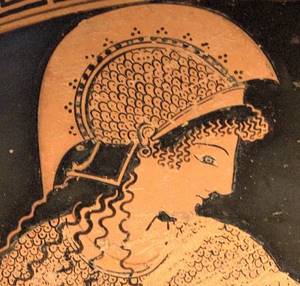
Athena on the Euphronius vase, book VI - n. V century BC e. (late archaic)
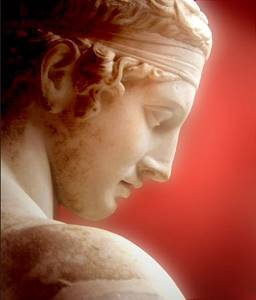
Head of Diadumen, sculptor Polykleitos, c. 430 BC e. (high classic)
Greek diet
Greek women paid great attention to their appearance. They are known to have a special passion for food, so it is not surprising that they had curvaceous figures. However, in order for the shapes to be seductive, similar in shape to an hourglass, Greek women try to monitor their diet. This is why Greek women in the photo look so harmonious. Among the national Greek dishes you can notice many recipes from meat, fish and vegetables. No wonder Greek women are beautiful. All over the world, nutritionists have repeatedly drawn attention to the fact that Greek cuisine is an example of separate nutrition: here eggplants are baked with potatoes, cheeses are eaten with tomatoes, and meat and fish are eaten separately from each other and without a side dish.
Greek character
Women of Greece (and not only them, by the way, men too) are bright individualists who have their own view of this life and are not afraid to contrast it with the opinion of society. They have a habit of defending only personal interests and, most often, they are neutral towards cultural, economic and political events that do not affect their personal world.
What no Greek will certainly tolerate is an attack on the freedoms of his country and his personal freedom. This is not surprising, since the worship of democracy is in the blood of modern Hellas. If there is the slightest hint of infringement of its rights, the Greek population can turn into a formidable force that is ready to rush at the enemy.
Another typically Greek trait is pronounced emotionality. To express their feelings, Greeks do not see the need for half measures. If they cry, it’s sobbing, and if they laugh, it’s with all their hearts. Even the famous steadfastness and thoughtfulness of Greek fishermen is only a confirmation of this feature of their character, since only very emotional people can immerse themselves in their inner world with the same passion with which they would indulge in fun and joy at their own daughter’s wedding.
It is also necessary to pay attention to the famous Greek hospitality, elevated by the Greeks themselves to the rank of a national tradition revered with special awe. Arriving in Greece, you will encounter this at almost every turn. The waiters will be very happy to explain to you what dishes the chef was especially able to prepare today, the store clerks will take your order with a polite and kind smile, and the hotel staff will surround you with attention and real home care. If you have business partners or friends in Greece, and you need to come to visit them, get ready for a meeting in comparison with which even the much-praised Russian hospitality will pale. This will not be just an ordinary dinner, but a real feast, where the tables will be laden with delicious dishes, the wine will flow like a river, and there will be no end to the songs and dances.
It’s very funny that two more completely opposite traits are also harmoniously combined in the Greek character: the famous business acumen of the Greeks and the no less famous Greek piety.
Greek clothing
The ancient Greeks not only achieved great success in various spheres of culture, but also succeeded in the art of dressing well: they were the first to come to the idea that people in their splendor are like gods, and the human body is a mirror reflecting the ideals of the universe.
The main elements of the national costume in Ancient Greece were: the himation, which was a cape that was draped to emphasize the figure, and the chiton, which was underwear. Based on the moral requirements of that era, clothing for Greek women was longer than men's and covered almost the entire body. It also consisted of a himation and a chiton, but was much more colorful and brighter. However, wearing colorful clothes was not welcomed by the Greeks. To make a single-color outfit more interesting, it was decorated with elaborate patterns and embroidery.
Today, clothing for women in the Greek style is not only part of the country’s history, but also an inspiration for designers and fashion designers from all over the world to create creations of modern fashion art that attract fashionistas with their elegance and lightness.
The shape of the nose is what we pay attention to intuitively. A large nose catches the eye and alarms, while an extraordinary nose attracts the eye. Upturned encourages not to take a person seriously. Let's talk in more detail about what types of noses there are and what they can say about a person.
Based on an analysis of a person’s appearance, one can determine his character traits. This is the science of physiognomy. It has ancient roots. This term was also used by Hippocrates in his writings. Physiognomy believes that the shape of the nose can determine the success of a person.
The main indicators for comparing the character and shape of the nose are its size, length, width, type of nostrils, as well as the presence of other features (hump, ridge)
According to physiognomy, the shape of the nose can say a lot about its owner. Science focuses on its proportionality and harmony in relation to other parts of the face. What does the shape of the nose say?
Let's look at the pictures to see what types of noses there are:
Roman nose - to execute or pardon?
Rome... The majestic city, the beauty of which conquers the hearts of travelers and excites the blood of lovers, originated in the 9th century BC and was a small Italian village on a hill. But already in the first century, during the reign of the legendary Julius Caesar, Rome became the center of the powerful Roman Empire; it replaced more than one emperor in the history of its existence, whose faithful assistant at all times was the legion - the ancient Roman warriors.
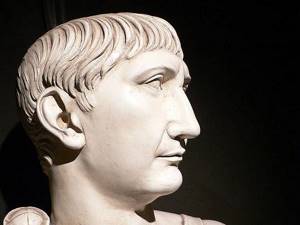
While historians are desperately arguing about what the secret of the valor and courage of the Romans is, the public is interested in other, more pressing issues. One of them was the Roman nose. What is he?
Roman nose! You can admire this attribute of masculinity, be proud of it, share your unique profile on social networks, or, conversely, experience excruciating suffering from the hated hump and deliberately take pictures from the front. Yes, you can hate the Roman nose... But you can elevate it to the rank of your best virtues and walk along the roads of fate with your head held high!
The Roman nose is distinguished by its piquant hump, slightly curved tip and very refined shape. It should not be confused with Titian's Greek, which is excessively straight and long. It also differs from the Caucasian one - massive and completely hunchbacked. The Jewish nose is also inferior to the Roman one in its ornate hook. It is safe to say that the Roman nose absorbed all the best that nature could give to a wide variety of nations.
Physiognomy characterizes its “carriers” as heroic, warlike, wise people. They are able to get to the root and make the necessary decisions in the shortest possible time. The Roman nose, a photo of which can be found in any cultural publication on the history of Rome, often endows its owner with a fair amount of ambition, which, however, greatly helps in achieving material and spiritual well-being.
A person with a Roman nose is distinguished by her composure; it is unlikely that she can be enraged by a trifle. However, there is no point in expecting mercy, and if the unspoken descendant of the Romans rushes to administer justice, the execution will be exquisitely cruel.
Unfortunately, some owners of the Roman profile are ready to fall into the ground when it comes to the beauty of such an intimate part of the body.
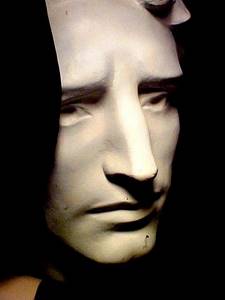
They will claim that a beautiful nose can be straight, upturned, wide, long - anything, but without a hump. Probably such naive statements stem from some incompetence. Perhaps they should visit Italy or go to a couple of museums to look at the valiant brothers of Ancient Rome? The situation is aggravated by imposed stereotypes of beauty: on websites with rhinoplasty services, they first of all offer to get rid of the beauties of the Roman nose - “straighten and straighten.”
Curious what lies at the root of such proposals and subsequent complexes? Is the encroachment on the splendor of natural forms due only to financial aspects? However, this is a completely different story that has nothing to do with aesthetics.
The Roman nose lived, is alive and will live!
What is the perfect nose?
You can find different shapes, but the most correct, in other words, the ideal shape of the nose has been identified:
A long, bony one indicates traits such as quarrelsomeness, arrogance and pride.
If this part of the face is long and straight, the person is logical and consistent. One can envy him in his ability to plan things.
If the tip is prominent, such a person is a storehouse of secrets, but others may not worry about disclosing them. The personality is also distinguished by insight, loves and respects money
How to determine character by the bridge of the nose?
This is the upper part of the nose under the bridge of the nose. It is also a rather interesting element of the face and, it turns out, can tell about important personality characteristics.
Hump (wavy back)
She reveals the uniqueness of her personality. According to physiognomy, a hump is, first of all, self-control inherent in a person. In general, the character of the owner of such a nose is characterized by creative inclinations. These people love new ideas and creativity in everything. They consider themselves experts in all areas.
If the hump is located closer to the tip of the prominent part of the face, the person is capable of rapid changes of strength, mobilization, and knows how to defend himself. The hump in the center is a defining feature of noble people who love to be heroes and protect the weak. When the “decoration” is located closer to the bridge of the nose, its owner is cocky, aggressive, and always ready to fight back.
Convex back
Owners of this element do not tolerate being commanded. They like to work alone, are hardy and efficient.
The back is wide and high
This nose is called Greek. As for the owner of such a nose, we can say that he is distinguished by an iron will. Often such men and women are leaders; they know exactly what they want. Stubborn.
Four typical nose sizes
There are many types of noses. One of the criteria for their characteristics is size. In terms of size, noses range from large to small and long to short.
- So, a person with a large large nose
is usually self-confident, selfish and passionate. He prefers to lead and command, and act independently. - The owner of the small nose
has little patience and gets frustrated quickly, but loves to play in a team, come to the rescue and solve problems creatively. - A long nose
indicates that its owner is ambitious and businesslike, capable of raising and solving the most complex tasks and problems. - People with short noses
do not like to lead; they are more driven than proactive, but they are loved for their emotionality, kindness and sensitivity.
What can the tip of the nose say about personality?
The tip of the nose is an element that cannot be ignored when analyzing facial features.
| This nose shape can say a lot of interesting things about your personality, but not very pleasant ones. An aquiline nose belongs to a vain, ambitious person. The shape is memorable, but not everyone likes it - the female sex is intuitively wary of men with such noses. However, with a small size, the protruding part of the face looks quite attractive | |
| Small | Denotes jealousy, pettiness. But a short nose of medium width will indicate such personality traits as impulsiveness and openness. Its owner is an active, serious person |
| Snub | The nose belongs to people who are sociable, trusting and optimistic. Such traits indicate a person’s responsiveness, but at the same time touchiness. As a rule, such people have good taste |
| Potato nose | Characterizes a kind-hearted person. He loves comfort and a friendly environment |
| Cocked | This is impulsiveness and impressionability of a person. If it is pulled up too tightly, the person always cares about other people's secrets |
| Raised up and pointed | His owner probably has difficulty saving money and is quite wasteful |
| Bent down | Suspiciousness and prudence of the individual. But such people get along well with finances |
| The tip, bent to the bottom, is pointed | You should be careful when communicating with such a person. This form speaks of selfishness and cruelty |
| The tip of the nose is shaped like an eagle beak | Means cunning and vindictiveness |
| Drooping nose tips | They may indicate sexual preoccupation or excessive interest in sex issues |
| Forked nose tip (with a pit) | They mean a seeking person. She can often change jobs in the desire to achieve emotional satisfaction in her activity. This person is usually shy |
| Pointed nose tip | Tendency to self-control. Often such people have talent in musical art |
Let's move on now to the stronger sex
People with a hump
– are arrogant and do not like to take into account other people’s opinions. At the same time, they do not have a large arsenal of means to achieve their goals: their element is a dashing artillery attack.
Constancy and commitment are not the strongest character traits of such a man, but with one caveat: until he meets the one for whom he is ready to sacrifice his freedom!
The “Romans” are not much different from such men. Holders of the Roman
noses are also somewhat arrogant, even arrogant and very conservative. They prefer to dominate in any relationship, sometimes they can show aggression. Paradoxical as it may seem, for a smart woman to wrap such a type around her finger is not particularly difficult.
If you prefer soft, kind, easy-going comrades, look for them among those with potato
. Absolutely non-conflict, sometimes shy, often religious people.
A woman's favorite item of clothing for them is a certain part of her shoes. You understood me correctly. A real find for ladies who are not inclined to compromise. Yes, I almost forgot: in bed they prefer to work as “number two” and unquestioningly obey their other half.
Snub-nosed
men are generally energetic and love to live life to the fullest. They are great lovers of life, and their temperament sometimes goes over the edge. Despite their temper and sometimes excessive harshness, their natural intelligence almost always restrains them from rash actions. And the snub-nosed organ of smell can smell profit a mile away!
an eagle eye are even more hot-tempered.
profile. In addition, they are quite vindictive towards their offenders. And these comrades, rare in our country, are distinguished by their prudence and stinginess, they love money, and this love is almost always mutual. They have a stormy temperament that does not respect boundaries.
Men with thin
and with a nose pointed towards the bottom, they have a delicate, vulnerable, even capricious nature. It’s easy to offend them, it’s not even difficult to squeeze out a tear from them. In family life they are distinguished by reliability and constancy, they love children very much.
Men with short
nose belong to the category of “eternal students”. They have inexhaustible optimism, are sociable, cheerful, and are the soul of any company. Even at 50-60 years old, they look almost the same as at 30. It’s difficult to call them careerists, but they are very attached to their family.
Owners of direct
noses are honest, obliging, have an even character, and are quite energetic. They have a penchant for financial transactions.
And finally, meaty
the nose is a sign of a person who is successful in all respects: love, career, business - they easily achieve their goals in everything. They are thorough and economical, have a good sense of humor. In a word, the ladies are delighted with these!
With this, let me bow out. Don’t blame me if someone didn’t see themselves here from the most attractive side. Look at life with humor!
The nose is the architectural center of the face; for this reason, quite a lot of attention is paid to its shape and size. There is a whole science - physiognomy, which studies the influence of the physical features of the structure of the human body on his character and destiny. What qualities does an aquiline nose endow its owners with?
Nostrils
Protruding or too small nostrils are no less striking than the shape of the protruding part of the face.
Small nostrils characterize their owner as a thrifty person. Usually he is careful about finances and does not believe that they can be enough.
Large ones, on the contrary, indicate that the person is generous and ambitious. But at the same time, he can be vindictive and arrogant. If the nostrils are flared or huge, the person often takes on a lot. A person can go to extremes and take on too much responsibility.
Round nostrils, as a rule, mean generosity and high dedication. Rectangular ones reflect conservatism, and the fact that a person is in harmony with money. Triangular ones will speak of stinginess, extreme frugality.
Narrow and long nostrils mean that a person likes to provide emotional support to others.
Beauty or ugliness?
Psychologists say that the perception of one's own appearance largely depends on self-esteem in general. If a person loves himself, he easily accepts any imperfections of his own body. Significant dissatisfaction with your face is a sign of complexes and other psychological problems. And yet, an aquiline nose is truly a specific feature of the face. It all depends on the shape and size.
Women can be advised to take pictures from different angles, try several makeup options, and only then proceed to assessing their own appearance. In combination with large and beautiful eyes, an aquiline nose can only make a face more expressive and interesting. In some situations, this feature may look inappropriate. If the nose is large and downturned, it can stand out strongly on the face. In this case, it makes sense to think about correction.
Which one is more beautiful?
Facial features, including the shape of the nose, are inherited. Men, as a rule, do not think about their beauty and correctness. But women attach great importance to this. A prominent, large nose or with a hump can cause embarrassment and complexes in women. However, an extraordinary nose, for example an eagle or Greek one, makes the appearance more memorable and even adds charm.
The preferred nose shape for men is a hooked or straight nose, as well as a Greek nose. Representatives of the stronger sex value extraordinary forms more than ideal ones. In addition, it is believed that a large nose is an indicator of sexual temperament.
Today, with the development of plastic surgery, changing the appearance of the nose is not difficult. You can become the owner of its correct shape or any one you like. But the question arises: will this change a person’s character traits? Despite the fact that appearance influences the inner world and character traits, the happiness of each of us and harmony with the world still depend on more complex internal factors. Human character is, first of all, the depth and breadth of the soul. Love and appreciate yourself, no matter what flaws you find in your appearance!
Today it is very difficult to find a woman who is completely satisfied with the shape and size of her olfactory organ. Often representatives of the fair sex are very complex because of this. There are approximately 15 groups in total that are used to classify the nose. Each of them is based on several parameters: length, root, direction of the base, shape of the tip and back. These basic characteristics determine the shape of the olfactory organ.
A question of realism

The Benaki Museum of Greek Civilization displays a photograph of the “girl from Ipati”, which has a classic Greek profile and facial features[6]. The Greek nose is also found among modern Greeks, for example, the artist Sakis Rouvas, the singer Dimos Anastasiadis. The Greek nose may have represented ideal facial beauty, probably due to its rarity.
| Teacher: Children, what is the ideal angle in geometry? Class: (in unison) The angle that the Greek nose formed with the land of Greece! (Girado. Intermezzo) |
Anthropologists' opinion
| This section of the article has not been written. According to the plan of one or more Wikipedia contributors, a special section should be located in this place. You can help by writing this section. This mark was set on April 30, 2020 . |
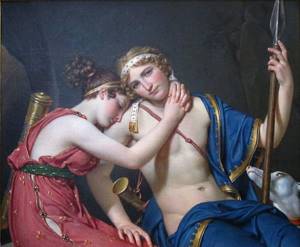
, 1st half. XIX century An example of an image of ancient heroes with a Greek profile from the front (in classical painting of modern times)
A little history
In the territory of Ancient Rome and Ancient Greece, the correct shape of the nose was highly valued. This is why such concepts as the Greek or Roman nose arose. These forms are found in ancient images and sculptures. The ancient Greeks were attracted by the clarity of lines, so the ideal face must have expressive eyes, a low forehead, blond hair and a straight, thin nose.
In those distant times, noble and strict attractiveness was very fashionable. Ladies rarely cut their hair; they tied it with ribbons or styled it in a knot. This hairstyle is called the “antique knot”, and it is very popular even today.
Times, as we know, are constantly changing; modern representatives of the fair sex today pay special attention to the images that are shown to them on television screens, shown on the Internet and in glossy magazines. There they see modern standards of female attractiveness with perfect facial features, body shapes and nose. Some, influenced by what they saw, resort to rhinoplasty.
What does a Roman and Greek nose look like: photo, character description
The nose is the architectural center of the face, as it occupies the central region. The most difficult thing is to find a woman who will consider her nose to be absolutely perfect; basically, the majority are always unhappy with their nose and therefore have a lot of complexes about it.
In total, there are about fifteen groups into which this area is classified, each of which carries five main parameters - the root, the shape of the back, the direction of the base, the tip and the length.
All of these are basic features that affect the shape of a given organ.
History lesson
In Rome, as well as Ancient Greece, in addition to a beautiful body, women valued noses, as they specified “the correct shape”, apparently this is where the concept of Greek and Roman noses came from.
This so-called standard of female beauty can be seen in ancient sculptures that display all the beauty of women in that era.
In Ancient Greece, mostly people valued clear straight lines, or you can also call them “correct”; in such cases, the girl’s face had to have a low forehead, on which were slightly curled curls of light-colored hair, a thin expressive nose, as well as huge beautiful expressive eyes.
In that era, beauty was very noble and at the same time strict. Women did not cut their hair at all, did not cut their hair, but on the contrary, they grew it more and more, after which they braided themselves a huge braid, or, more simply put, they tied their hair in a knot and rewound it with a ribbon, this hairstyle is called the “Antique Knot” and to this day helps a certain percentage of women in various events.
In Ancient Egypt, people most respected a fairly slender body and long legs, without any thinness. The people of Egypt used cosmetics, drawing beautiful bright eyebrows for themselves, and using it to create expressive eyes.
In fact, times are changing, and modern women and girls mainly glance at television screens and glossy magazines with their covers, where they find for themselves examples of beauty with straight facial features, impeccable body shapes and a naturally correct nose shape.
Almost everything seen directly forces a woman to take such a step as rhinoplasty.
Characteristics of people with a Greek nose
Few Hollywood celebrities have not resorted to plastic surgery of the olfactory organ. They are often pushed to this by the specifics of their profession. The changes can be seen if you study photographs at the very beginning of your career and after a few years, the difference will be obvious.
Greek profile
- a classic version, which is characterized by straight shapes. This nose does not need any correction. The sculptures left over from the ancient Greeks are ideal and beautiful, they have ideal forms, and the Greek profile is one of the components of these works of art. This appearance was characteristic of gods and demigods, which was considered the standard of perfection.
The Greek profile of a girl has characteristic features, which include the continuation of the forehead line. However, in the area of the bridge of the nose there may be a small depression that does not violate the general line. The Greek nose in women and men differs only in size. The more refined one is considered the most attractive in a woman.
It is noteworthy that the Greek form may indicate the following character traits of its owner:
- independence and pride;
- leadership and adherence to principles;
- aversion to liars and affection for comrades;
- love of wealth and generosity;
- the desire to control all financial issues and some sarcasticness.
People with a Greek nose have a very restrained behavior; they never panic, use logical thinking and have excellent control over their emotional state.
Roman and Greek nose: characteristic features of the profile, character traits of its owners
Today it is very difficult to find a woman who is completely satisfied with the shape and size of her olfactory organ . Often representatives of the fair sex are very complex because of this.
There are approximately 15 groups in total that are used to classify the nose. Each of them is based on several parameters: length, root, direction of the base, shape of the tip and back.
These basic characteristics determine the shape of the olfactory organ.
In the territory of Ancient Rome and Ancient Greece, the correct shape of the nose was highly valued. This is why such concepts as the Greek or Roman nose arose. These forms are found in ancient images and sculptures. The ancient Greeks were attracted by the clarity of lines, so the ideal face must have expressive eyes, a low forehead, blond hair and a straight, thin nose.
In those distant times, noble and strict attractiveness was very fashionable. Ladies rarely cut their hair; they tied it with ribbons or styled it in a knot. This hairstyle is called the “antique knot”, and it is very popular even today.
Times, as we know, are constantly changing; modern representatives of the fair sex today pay special attention to the images that are shown to them on television screens, shown on the Internet and in glossy magazines. There they see modern standards of female attractiveness with perfect facial features, body shapes and nose. Some, influenced by what they saw, resort to rhinoplasty.
Characteristics of people with a Greek nose
Few Hollywood celebrities have not resorted to plastic surgery of the olfactory organ. They are often pushed to this by the specifics of their profession. The changes can be seen if you study photographs at the very beginning of your career and after a few years, the difference will be obvious.
The Greek profile is a classic version, which is characterized by straight shapes. This nose does not need any correction.
The sculptures left over from the ancient Greeks are ideal and beautiful, they have ideal forms, and the Greek profile is one of the components of these works of art.
This appearance was characteristic of gods and demigods, which was considered the standard of perfection.
https://youtu.be/_p9FQ6_eoKI
The Greek profile of a girl has characteristic features, which include the continuation of the forehead line. However, in the area of the bridge of the nose there may be a small depression that does not violate the general line. The Greek nose in women and men differs only in size. The more refined one is considered the most attractive in a woman.
It is noteworthy that the Greek form may indicate the following character traits of its owner:
- independence and pride;
- leadership and adherence to principles;
- aversion to liars and affection for comrades;
- love of wealth and generosity;
- the desire to control all financial issues and some sarcasticness.
People with a Greek nose have a very restrained behavior; they never panic, use logical thinking and have excellent control over their emotional state.
Features of the Roman profile
This form also has features. This nose is slightly elongated and has a slightly curved tip. People with a Roman nose are considered very strong and courageous; they can both defend themselves and attack. Men with this form of the olfactory organ are distinguished by their composure and clear thinking. They are very brave, never afraid to stand up for themselves and their loved ones. Many people like such character traits, which is why men with a Roman nose often become very authoritative.
People who are characterized by a Roman profile include the following features:
If the Roman profile looks like a kind of “beak”, then this may indicate aggressiveness. Owners of this part often became adventurers and notorious adventurers. Individuals with a Roman profile are often considered very unreliable and cold-blooded. Small nostrils mean a love of risky endeavors. However, risks often bring with them great success.
The Roman nose in women or men may have a slight hump. This form is characteristic of the descendants of the ancient Romans. The Roman profile with a raised back was called aquiline. Such an organ was possessed by Julius Caesar himself, Charles the Fifth and Henry the Sixth.
It is impossible to assert that the shape of the olfactory organ can determine human character and actions. But there is an opinion that along with a change in the natural form, a person’s behavior, as well as his life path, can also change.
Eagle nose: photo and description
Eagle, hawk or Roman is a slightly elongated nose with a curved tip. Sometimes this form has a pronounced hump, but do not rush to get upset - in Ancient Rome such a feature was considered a sign of noble origin. The classic Roman profile was proudly minted on coins and painted on ancient frescoes.
Today, many people do not like the aquiline nose. Most people consider themselves less beautiful than they really are. An aquiline nose looks quite harmonious on the face and is appropriate in most cases. And some people even like this shape; they consider it one of the signs of beauty of the opposite sex.

![[Photo review] “A Sassy Nation” bodysuit from Black Milk Clothing](https://superlady555.ru/wp-content/uploads/fotoobzor-bodi-a-sassy-nation-ot-black-milk-clothing-330x140.jpg)
